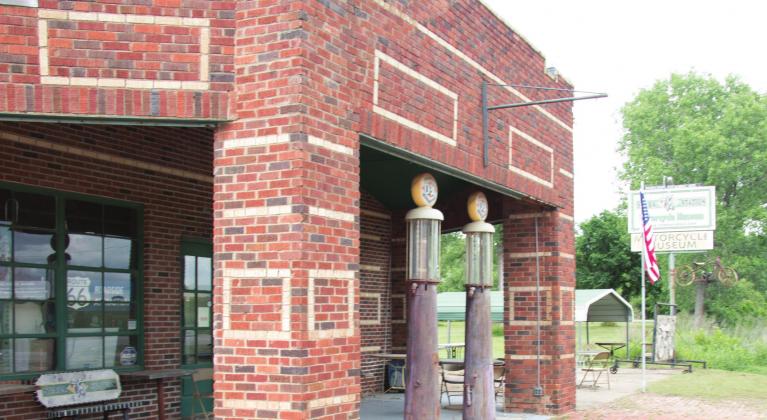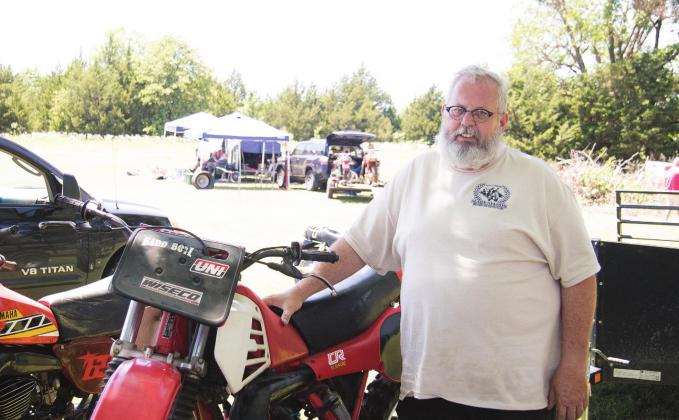Seaba Station Motorcycle Museum
With concerns over COVID-19 still looming, travel this summer may prove difficult. But that doesn’t mean that individuals can’t explore the attractions in their own backyard, that they may never have visited before. Route 66, known alternately as the “Mother Road” and “America’s Highway,” was formed in the 1920s as the first highway connecting Chicago and Los Angeles. Cutting straight across Lincoln County, the highway shaped a significant part of the region’s history, and its attractions offer an important glimpse into the past, as well as a welcome chance for fun without traveling far from home.
Sunlight reflecting off polished metal and the sound of revving engines filled the air Saturday, May 30, at Seaba Station Motorcycle Museums’s Swap Meet.
Surrounded by motorbikes and bikers, the historic Seaba Station was once a filling station, with a stone outhouse, along the historic Route 66 outside Warwick Okla.
Now, the site is a motorcycle museum and it regularly hosts swap meets such as this one, every spring and fall.
This swap meet marks the museum’s return to normal events after COVID-19 safety concerns required the rescheduling of the swap meet from the beginning of May.
“Absolutely marvelous,” museum owner Jerry Ries said. “Probably the best day we’ve ever had.”
Ries’ collaborator Gerald Tims estimated that the museum’s events typically have 25-50 vendors, and said that fair weather events were usually better attended.
“It’s just one of those things, turned out perfect,” Ries said. “You know, the weather and everybody wanting to get out because of being scooped up ‘cause of the virus so far. I had more vendors and more people.”
The side road beside the museum was lined with cars and motorcycles, midday May 30, and the field behind the museum was dotted with people and bikes.
The interior of Seaba Station also features a variety of motorcycles which fill the rooms almost to the point of overflowing.
“I think almost anybody could find something of interest in here - something they would enjoy looking at,” Ries said.
The museum currently houses approximately 130 motorbikes, varying from bikes made in 1910, to more modern dirt bikes.
The majority of the bikes are owned by Ries or Tims, however the museum also features some bikes that are on loan or have been donated.
“Always on the lookout for other bikes and different bikes,” Ries said. “Always looking to find something else different or replace something with something else.”
Creating the museum was born out of the two men’s hobbies.
“I’ve always had an interest in bikes,” Ries said. “I was one of those that mom wouldn’t let me have a motorcycle when I was growing up. I like old things in general and so the two things just kind of mesh and let me put both of those loves together.”
The building was originally built by John Seaba in 1921 as a DX gas station. It transformed into a machine shop from the 1930s until 1994. Later it became an antique store.
“The building always fascinated me,” Ries said. “There was an antique store here at the time and I came by one time and there was a for sale sign there.”
Ries and Tims had been considering starting a museum for a while.
“We had talked about possibly opening a museum at another location and then he found that building,” Tims said. The result was Seaba Station Motor
The result was Seaba Station Motorcycle Museum.
Ries purchased the building 12 years ago and after some prep work, opened about two years later.
“When I bought the place as an antique store, I did buy the antiques that were in here,” Ries said. “And I went ahead and sold those out, then I started the remodeling process, did that, and then I brought the bikes in.”
Route 66 was not a large part of Rie’s frame of reference before starting the museum.
“I grew up in Iowa, so I was quite a bit away from that,” he said. “I knew the significance of it when I bought the building, so I was hoping that 66 would be good for the business, and it has been.”
The location has helped the museum gain visitors from all over the world.
“Before meeting all of the people who come through there -- I wasn’t aware of all the foreign travel on Route 66,” Tims said.
Ries said the museum has had visitors from Europe and elsewhere.
“This is not a normal period right now,” Ries said. “But I can have up to 1000 people a week just depending on if it hits, you know, different things right and so forth.”
Motorcycles themselves also have a worldwide appeal.
“It’s just kind of a freedom thing,” Tims said. “You can be out on the road or out on the trail or whatever and it’s basically just you and whatever’s in front of you. I think that’s probably most of it. And the adrenaline.”
The museum has free admission and is open Monday-Sunday 10 a.m-5 p.m. and is closed on Wednesdays.


